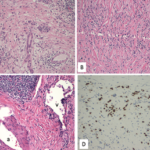The criteria were evaluated using an international cohort of approximately 1,900 patients with either IgG4-RD or a mimicking condition. A derivation cohort included 486 patients, the first validation cohort included 908 patients and the second validation cohort included 485 patients. The criteria steering committee used a data-driven approach that included consensus exercises, existing literature and multi-criteria decision analysis to identify, weight and test potential classification criteria. The investigators first generated potential clinical, serologic, radiologic and pathologic items, then established definitions for the entry, exclusion and inclusion criteria.
The steering committee used the derivation cohort to assess the relative performance of 78 proposed exclusion and inclusion criteria and to eliminate criteria that did not distinguish IgG4-RD cases from mimickers. The investigators then used multi-criteria decision analysis to assign weighted point values to each remaining inclusion criterion.
The variable nature of IgG4-RD presentation means that no single set of classification criteria can include all patients with the disease.
Sensitivity & Specificity Analysis
Because many diseases can mimic IgG4-RD, it is important that the classification criteria have a high degree of specificity, Dr. Stone explains. The investigators found that a threshold of 20 points achieved a high level of specificity while maintaining acceptably high sensitivity. Tested on the first validation cohort, a threshold of 20 points had a specificity of 99.2% and a sensitivity of 85.5%. In the second validation cohort, the 20-point cutoff had a specificity of 97.8% and a sensitivity of 82.0%.
Dr. Stone notes that the sensitivity of the criteria is remarkable considering the many different manifestations of IgG4-RD. However, the authors recommend further evaluation of the criteria against specific populations enriched for malignant conditions, such as non-IgG4-RD pancreatobiliary diseases and infection.
Exclusion & Inclusion Criteria
The IgG4-RD classification criteria use a three-step process. The first is to demonstrate that a patient’s disease involves at least one of the 11 organs most often affected by IgG4-RD: pancreas, salivary glands, bile ducts, orbits, lacrimal glands, kidneys, lungs, aorta, retroperitoneum, pachymeninges or thyroid gland (Riedel’s thyroiditis).
The second step is evaluating the exclusion criteria. The IgG4-RD classification criteria are the first ACR/EULAR criteria to include absolute exclusion criteria that are not based solely on having an alternative diagnosis, according to Dr. Stone, due to the many potential mimickers of IgG4-RD. When the steering committee applied the exclusion criteria, they found specificity improved by 10%.
The exclusion criteria for IgG4-RD include 32 clinical, serologic, radiologic and pathologic features, including recurrent fever without infection, rapid radiologic progression and prominent neutrophilic inflammation. The presence of any of these features eliminates the patient from IgG4-RD classification. Fever is rarely a primary presentation of IgG4-RD, Dr. Stone notes, and failure to respond to steroids suggests the patient does not have IgG4-RD. The exclusion criteria also direct rheumatologists to examine serum for the presence of antibodies that may indicate a different diagnosis. The exclusion criteria are not intended to serve as a checklist, but instead remind investigators to consider other evaluations appropriate to the clinical presentation.


